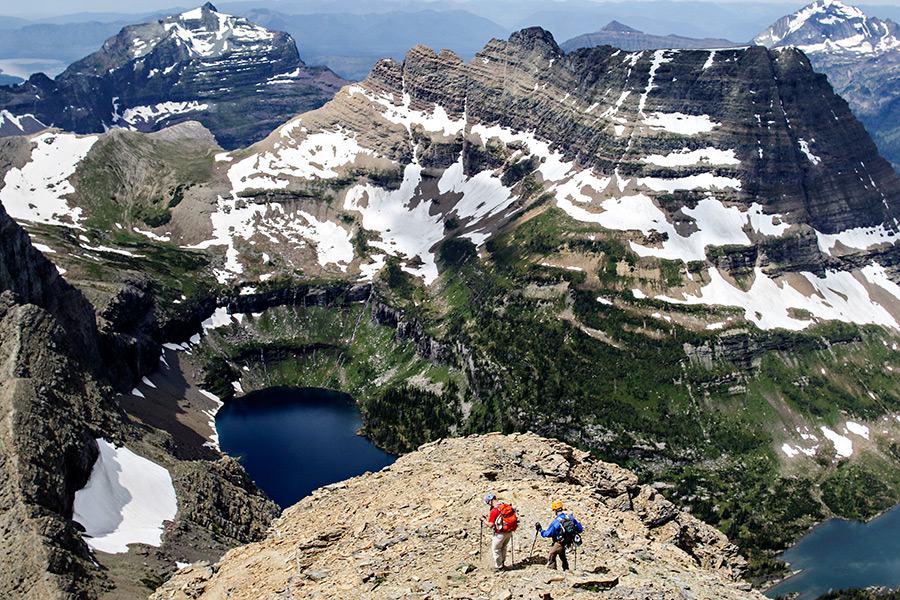As Glacier National Park enjoys an all-time high popularity among visitors, the nonprofit philanthropic organization that supports the Crown Jewel of the Continent is turning its attention to its latest priorities and support programs.
The Glacier National Park Conservancy has published its 2019 Field Guide to Park Project Priorities, a list of initiatives it hopes to support through private fundraising. The projects cover the three primary goals of the conservancy — preservation, education and research — and include short-term and long-term objectives, from creating safe opportunities to view wildlife to rehabilitating trails.
The conservancy picks its annual projects in partnership with the National Park Service and collects private donations to fund the programs and projects that the federal agency cannot necessarily tackle on its own.
For example, last year the conservancy provided $2 million in support of critical park projects, including a state-of-the-art observatory in St. Mary as part of the astronomy education program, slated for completion this fall. The conservancy also raised $73,000 for the Quartz Lake Bull Trout Preservation Project in partnership with Patagonia, which helped fill a year-long gap in federal funding.
With its sights firmly set on 2019, the conservancy is raising $2.3 million for 64 projects, not including reconstruction of the historic Sperry Chalet, which burned last summer in the Sprague Fire and is being funded through separate efforts.
Here’s a look at some of the projects in the conservancy’s queue.
2019 Park Priority Projects
Survey Glacier’s Lynx Population
Funding Needed: $74,300
The lynx is a secretive forest carnivore that has been little studied in Glacier National Park, even though the park comprises a significant portion of core lynx habitat in the northern Rockies. This landmark project will use 300 remote cameras to document large-scale distribution and abundance patterns of lynx within Glacier’s boundaries.
Glacier’s lynx likely persist at low densities due to threats from a variety of factors, but current understanding of those threats is incomplete. During the first year of a three-year study, the project will examine how climate change, reduction in snow cover and an increase in the frequency and intensity of forest fires impacts lynx.
Native Fish Conservation
Funding Needed: $97,300
A critical part of keeping Glacier’s ecosystem intact is the protection of its native cold water trout. The park’s population of migratory bull trout in alpine lakes and native westslope cutthroat trout is under threat from both intentional introductions of nonnative fish and the migration of nonnative species into the park. Funding from the conservancy will allow the park and its partner agencies to significantly leverage public funds to implement a highly technical, four-phase initiative that spans the park from Camas Lake, Evangeline Lake and Quartz Lake to multiple lakes and streams in the St. Mary River drainage and beyond.
Connectivity in the Crown
Funding Needed: $30,043
The U.S. Highway 2 corridor seems like a small intrusion to the ecosystems of Glacier National Park and the Bob Marshall Wilderness Area, yet it poses a major separation of two of the largest wilderness areas in the country.
The highway is slowly becoming a barrier to north-south wildlife movement in the Crown of the Continent ecosystem. Engineering for highway reconstruction will likely begin within the next five years, so it’s imperative that planning begins to ensure connectivity. Research on wildlife species of highest concern, prioritization of appropriate action by multiple stakeholders, and implementation of potential approaches like land conservation and retirement of leases can all require multiple years.
This project will fund a series of workshops to forge a research framework that can answer connectivity questions in a coordinated, collaborative and efficient manner. The park will deploy trail cameras and use GIS technology to determine appropriate potential locations for wildlife crossings on the U.S. Highway 2 corridor.
Prevent Catastrophic Mussel Infestation
Funding Needed: $130,000
In the past two years, the number of boats and other watercraft inspected as they enter Glacier Park increased from 1,000 in 2016 to over 13,000 in 2017. Continuing this program is critical not only to the park’s pristine waters, but to the greater ecosystem of the Columbia River Basin.
This project will provide private funds to leverage significant federal and state resources being allocated for this effort, and will support inspection stations in Polebridge, Two Medicine, St. Mary, Many Glacier, and Apgar.
Native America Speaks
Funding Needed: $58,000
This award-winning program, now in its 35th year at Glacier National Park, is the longest-running indigenous speaker series in the National Park Service. The conservancy’s grant funds 100 events in the park each year, attended by more than 7,500 visitors. This program provides a unique window into the meaning and history of Glacier from the different perspectives of the Blackfeet, Salish, Pend d’Oreille, and Kootenai tribes.
The conservancy will host its annual Backpacker’s Ball on Thursday, Aug. 2 at the Dancing Spirit Ranch in Columbia Falls. The evening features live and silent auctions of curated collections, one-of-a-kind items and unique adventures.
The Backpacker’s Ball is the conservancy’s signature event to support vital programs and projects in Glacier Park. Tickets are $150 and are available by contacting (406) 250-8031.
Gifts through the end of 2018 support these projects that will take place in 2019. To fund a project in full, contact Nikki Eisinger at (406) 892-3250 or [email protected].
